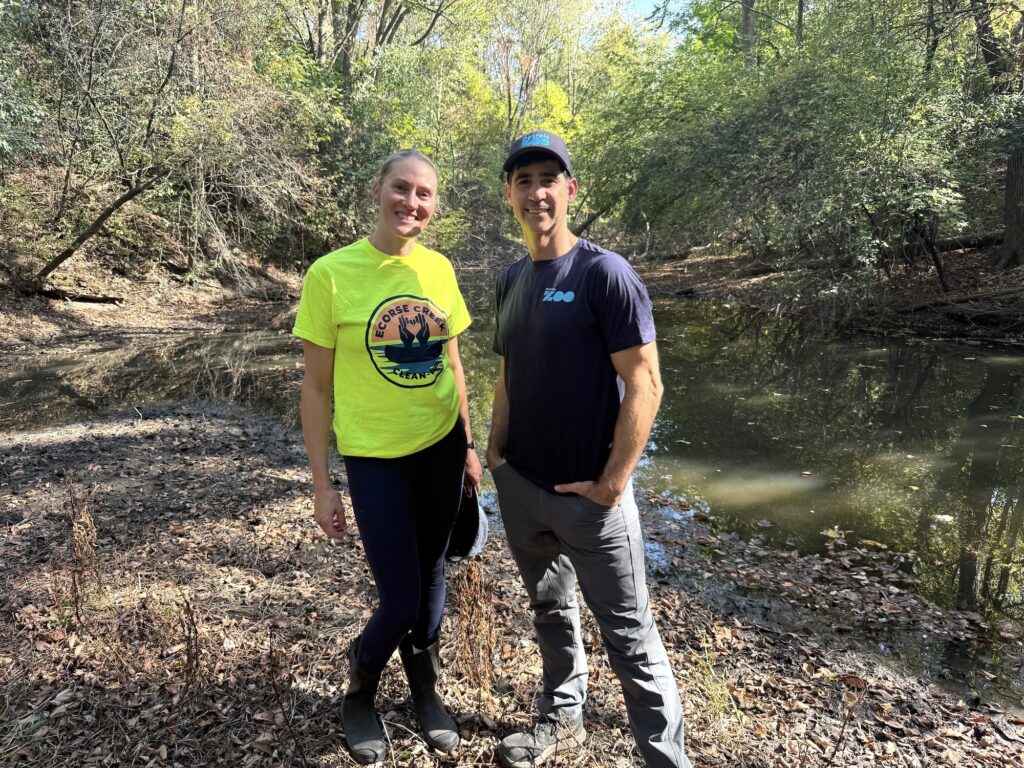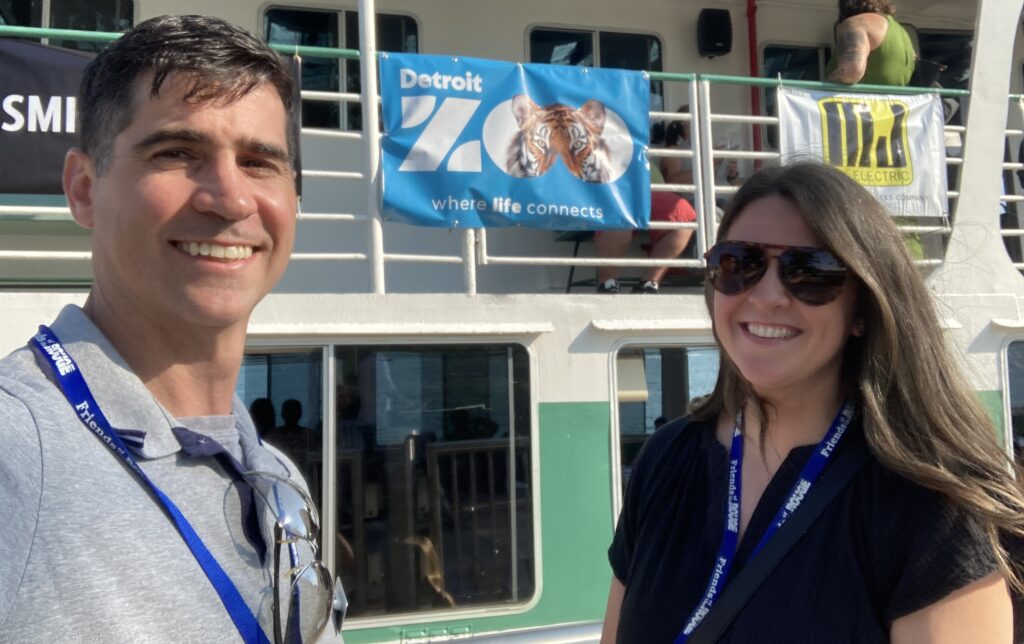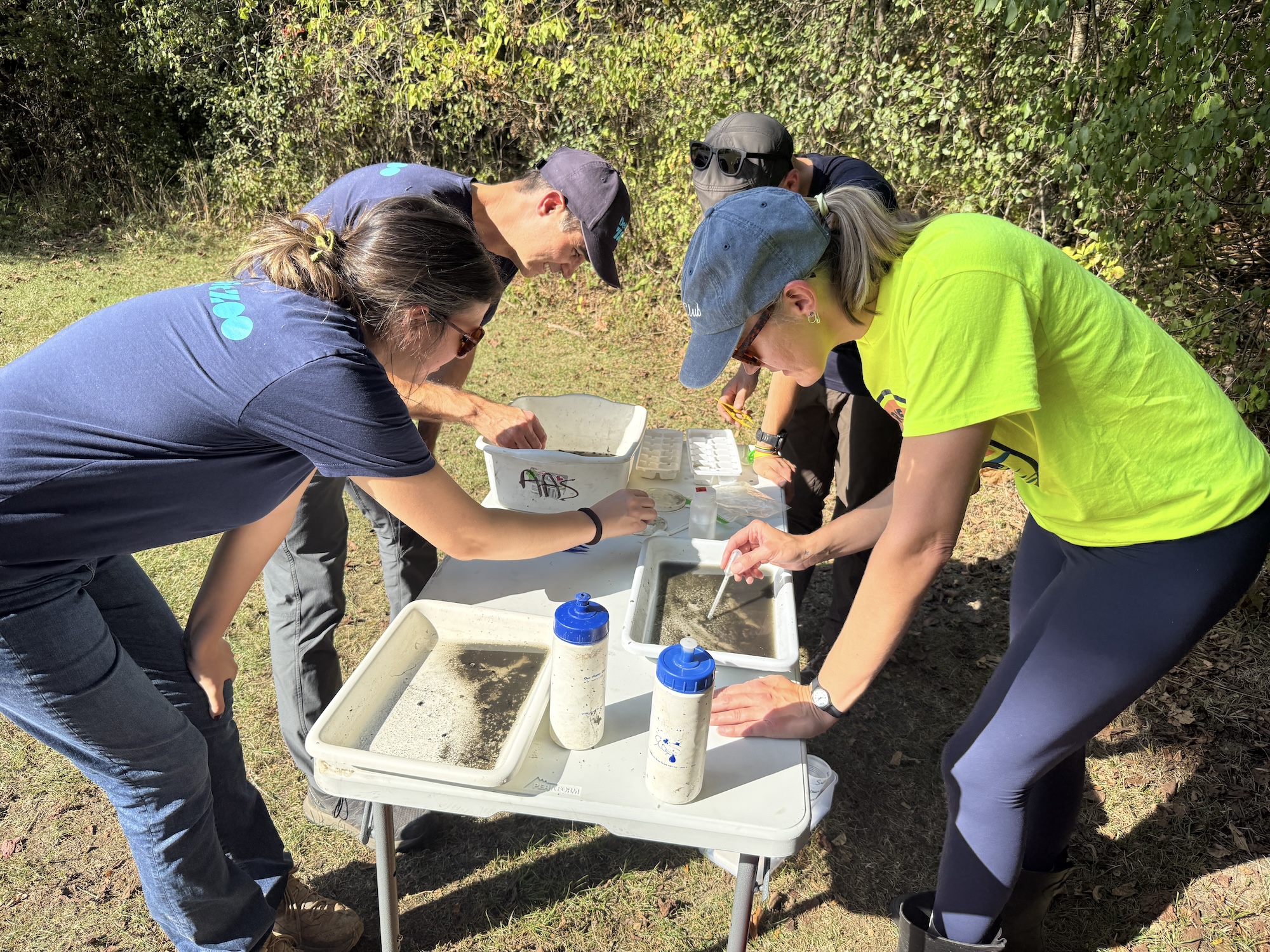On a warm fall afternoon at Beaver Creek Park in Sterling Heights, a small team from the Detroit Zoo crouched along the edge of a quiet tributary, collecting aquatic insects from beneath stones and submerged leaves.
The volunteers—staff from across the Zoo’s departments—carefully sorted mayflies, dragonflies, and caddisflies into trays of clear water.
The work is part of the Clinton River Watershed Council’s Adopt-A-Stream program, a 30-year-old volunteer monitoring effort that enlists hundreds of local residents to help track water quality across the 760-square-mile Clinton River watershed.
The 760-square-mile Clinton River watershed drains into Lake St. Clair. The Detroit Zoo’s Sustainability and Conservation staff adopted two monitoring sites on tributaries that feed into the Red Run Drain, which flows into the Clinton River.
The Zoo selected these sites because its campus lies within the Red Run watershed and contributes stormwater to the George W. Kuhn Drainage District—a combined sewer system that conveys stormwater runoff and wastewater to the Detroit Water Resource Recovery Facility during routine flows, but during high-flow events can experience combined sewer overflows at the GWK Retention Treatment Basin.
“Conservation is local,” said Jennifer Hill, executive director of the Clinton River Watershed Council. “The fact that the Detroit Zoo is making it a priority for its employees to monitor water quality during the workday is amazing. Without volunteers like them, we simply couldn’t collect this data.”
A local link to a regional water story
The Red Run subwatershed is among the most urbanized areas of the Clinton River system. It drains much of Oakland and Macomb counties, carrying stormwater from rooftops and parking lots downstream. Despite these pressures, recent data show signs of gradual improvement.
According to CRWC’s 2024 Adopt-A-Stream Report, volunteers collected more than 5,000 aquatic macroinvertebrates representing 85 families, including 24 pollution-sensitive species last year. Sites monitored by the Zoo—Red Run 9 and Red Run 11—scored “fairly poor” but showed rising abundance of mayflies and net-spinning caddisflies, both indicators of improving water quality
“Everything we do on campus has a parallel in the community,” said Andy McDowell, the Zoo’s Manager of Sustainability. “Our work managing stormwater at the Zoo directly connects to what’s happening here in the watershed.”

From campus to creek
That on-campus effort includes a major stormwater management project led in partnership with regional organizations committed to watershed health, including the Oakland County Water Resources Commissioner’s Office. The project captures and manages rainwater on the Zoo’s property, allowing more to soak into the ground and reducing runoff to the Red Run Drain.
“The Detroit Zoo is one of Oakland County’s leading places for science and environmental education,” said Water Resources Commissioner Jim Nash. “Their new project will capture and manage all the rainwater that falls on their property—even during very large storms. By doing this, the Zoo helps protect our rivers, lakes, and groundwater and reduces strain on sewer systems.”
The project is supported by Pure Oakland Water, which also funds college-level internships that provide students with hands-on experience. One of those interns, Kendall Brabandt, helped launch the Zoo’s Adopt-A-Stream partnership in 2024.
“I wanted to do something participatory—something that connects people’s everyday actions to what’s happening downstream,” said Brabandt, a master’s student in Miami University’s conservation biology program. “Monitoring gives staff a meaningful way to engage with conservation right in their own watershed.”

Staff connecting beyond the Zoo
Participation in the program draws staff from departments far beyond the Sustainability and Conservation team. Kathleen Knutson, a Data Analyst in the Zoo’s Development Department, volunteered for both monitoring events in 2025.
“I usually work behind a computer screen,” Knutson said. “Getting outside, collecting samples, and learning about bugs that tell us how clean the water is—it’s a whole different perspective.”
Zoo teams collect and identify roughly 100 organisms at each site, including indicator species that help CRWC and state scientists assess pollution levels. The data feed into Michigan’s MiCorps water-quality database, where they inform state and local decision-making.
For Brabandt, the fieldwork is more than a scientific exercise. “This area has been shaped by industry and urbanization,” she said. “Helping connect people to local waterways—and to each other—feels like a way to make those impacts visible and positive.”
Inspiring local stewardship
The Zoo’s community partnerships extend beyond the Red Run. Staff have also supported cleanups along Ecorse Creek, one of the region’s most degraded waterways. Together, these initiatives reflect a growing emphasis on stewardship and education that complements the Zoo’s global conservation work.
“We want people to see the natural features around them and feel curious,” said McDowell. “Sustainability and conservation shouldn’t feel abstract—it’s about what’s right outside your door.”
Through projects like Adopt-A-Stream and its stormwater initiatives, the Detroit Zoo is linking habitat restoration, education, and infrastructure in a single message: what happens on the ground—at the Zoo, at home, or at a city park—ultimately flows downstream.
How to get involved
Residents and businesses can volunteer with the Clinton River Watershed Council’s Adopt-A-Stream program, which trains teams to monitor streams twice a year and contribute to statewide water-quality data. Learn more at crwc.org/data-dashboard.


